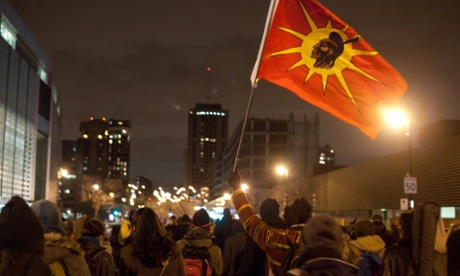Aboriginal rights based on treaties influencing Canada's resource development agenda
Aboriginal rights a threat to Canada's resource agenda, documents reveal
Posted by Martin Lukacs and Shiri Pasternak - Tuesday 4 March 2014
Canadian government closely monitoring how legal rulings and aboriginal protest pose an increasing 'risk' for multi-billion dollar oil and mining plans
 A man waves a Mohawk flag at a Montreal demonstration in support of the indigenous Idle No More movement in January, 2013. Photograph: Oscar Aguirre/Demotix/Corbis
A man waves a Mohawk flag at a Montreal demonstration in support of the indigenous Idle No More movement in January, 2013. Photograph: Oscar Aguirre/Demotix/Corbis
The Canadian government is increasingly worried that the growing clout of aboriginal peoples' rights could obstruct its aggressive resource development plans, documents reveal.
Since 2008, the Ministry of Aboriginal Affairs has run a risk management program to evaluate and respond to "significant risks" to its agenda, including assertions of treaty rights, the rising expectations of aboriginal peoples, and new legal precedents at odds with the government's policies.
Yearly government reports obtained by the Guardian predict that the failure to manage the risks could result in more "adversarial relations" with aboriginal peoples, "public outcry and negative international attention," and "economic development projects [being] delayed."
"There is a risk that the legal landscape can undermine the ability of the department to move forward in its policy agenda," one Aboriginal Affairs' report says. "There is a tension between the rights-based agenda of Aboriginal groups and the non-rights based policy approaches" of the federal government.
The Conservative government is planning in the next ten years to attract $650 billion of investment to mining, forestry, gas and oil projects, much of it on or near traditional aboriginal lands.
Critics say the government is determined to evade Supreme Court rulings that recognize aboriginal peoples' rights to a decision-making role in, even in some cases jurisdiction over, resource development in large areas of the country.
"The Harper government is committed to a policy of extinguishing indigenous peoples' land rights, instead of a policy of recognition and co-existence," said Arthur Manuel, chair of the Indigenous Network on Economies and Trade, which has lead an effort to have the economic implications of aboriginal rights identified as a financial risk.
"They are trying to contain the threat that our rights pose to business-as-usual and the expansion of dirty energy projects. But our legal challenges and direct actions are creating economic uncertainty and risk, raising the heat on the government to change its current policies."
A spokesperson for the Ministry of Aboriginal Affairs declined to answer the Guardian's questions, but sent a response saying the risk reports are compiled from internal reviews and "targeted interviews with senior management in those areas experiencing significant change."
"The [corporate risk profile] is designed as an analytical tool for planning and not a public document. A good deal of [its] content would only be understandable to those working for the department as it speaks to the details of the operations of specific programs."
Last year Canada was swept by the aboriginal-led Idle No More protest movement, building on years of aboriginal struggles against resource projects, the most high-profile of which has targeted Enbridge's proposed Northern Gateway pipeline that would carry Alberta tar sands to the western coast of British Columbia.
"Native land claims scare the hell out of investors," an analyst with global risk consultancy firm Eurasia Group has noted, concluding that First Nations opposition and legal standing has dramatically decreased the chances the Enbridge pipeline will be built.
In British Columbia and across the country, aboriginal peoples' new assertiveness has been backed by successive victories in the courts.
According to a report released in November by Virginia-based First Peoples Worldwide, the risk associated with not respecting aboriginal peoples' rights over lands and resources is emerging as a new financial bubble for extractive industries.
The report anticipates that as aboriginal peoples become better connected through digital media, win broader public support, and mount campaigns that more effectively impact business profits, failures to uphold aboriginal rights will carry an even higher risk.
The Aboriginal Affairs' documents describe how a special legal branch helps the Ministry monitor and "mitigate" the risks posed by aboriginal court cases.
The federal government has spent far more fighting aboriginal litigation than any other legal issue - including $106 million in 2013, a sum that has grown over the last several years.
A special envoy appointed in 2013 by the Harper government to address First Nations opposition to energy projects in western Canada recentlyrecommended that the federal government move rapidly to improve consultation and dialogue.
To boost support for its agenda, the government has considered offeringbonds to allow First Nations to take equity stakes in resource projects. This is part of a rising trend of provincial governments and companies signing "benefit-sharing" agreements with First Nations to gain access to their lands, while falling short of any kind of recognition of aboriginal rights or jurisdiction.
Since 2007, the government has also turned to increased spying, creating a surveillance program aimed at aboriginal communities deemed "hot spots" because of their involvement in protest and civil disobedience against unwanted extraction on their lands.
Over the last year, the Harper government has cut funding to national, regional and tribal aboriginal organizations that provide legal services and advocate politically on behalf of First Nations, raising cries that it is trying to silence growing dissent.
